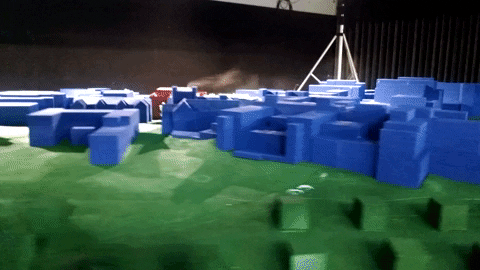New Engineering Building Will Lead in Sustainability, Low Energy Use
May 7, 2019
From roof to basement, the project sets a high level of achievement in sustainable design

From the recycling of construction waste during its three-year building process to super-efficient heating ventilation and cooling (HVAC) system that will serve it for years to come, Duke’s New Engineering Building sets a high level of achievement in sustainable design.
“The New Engineering Building was designed to support Duke Engineering’s innovations in education, research, and service to society,” said Mitchell Vann, director of facilities, infrastructure and safety at Duke Engineering. “But it also matches up with our longtime commitment to sustainability—particularly reducing waste and energy consumption.”
“An accomplished team with deep experience in sustainable design was brought together for this project.”
BILL MCCRAW
DUKE FACILITIES MANAGEMENT
Scheduled to open in November 2020, the $115-million, 150,000-square-foot building is now under construction off Research Drive near the nexus of Duke’s central Abele Quad, the Duke University Medical Center and existing engineering buildings.
It is rising across Telcom Drive from the Fitzpatrick Center, which opened in 2004 as one of Duke’s first facilities built to industry-wide sustainability standards known as LEED. In 2008, the Duke SmartHome, which began as a project of Duke Engineering undergraduates, opened the first live-in LEED Platinum building on a college campus.
The Duke campus is now home to 44 LEED-certified buildings, with the New Engineering Building among four currently under construction at Duke. Its design and construction teams are aiming for at least silver certification.
SUSTAINABLE FEATURES MEET OR EXCEED LEED SPECIFICATIONS
The New Engineering Building has sustainable features that meet, and some places, exceed LEED specs, said John Duffy, principal of the building’s engineering firm, Affiliated Engineers Inc. AEI worked with the building’s designers and architects, Bohlin Cywinski Jackson. The building contractor is Skanska.
Duke Engineering and Duke University made sustainable design a high priority.
“An accomplished team with deep experience in sustainable design has been brought together for this project,” said Bill McCraw, staff architect, and project manager in Duke’s Facilities Management Department. “Bohlin Cywinski Jackson and AEI both bring strong expertise in sustainable design, and Skanska is well-versed and diligent in sustainable construction practices.”
While students, faculty, staff, and visitors will experience a comfortable building interior filled with natural light throughout its five floors, much of the sustainable technology will be working nearly silently, unseen within building beams and mechanical spaces.
MODELED IN A WIND TUNNEL

Wind-tunnel testing of a model of Duke's New Engineering Building.
One of the most intensively designed systems is on the roof—the lab exhaust system.
Detailed wind tunnel modeling, unusual for an academic building, was used to precisely determine the lowest safe velocity for the systems that exhaust air from labs –1,200 feet per minute (fpm) instead of an experience-based estimate of 3,000 fpm without wind-tunnel modeling. The reduced exhaust velocity will reduce the amount of electrical energy used for ventilation while ensuring that both indoor lab air and the environment around the outside of the building are safe.
"The New Engineering Building matches Duke Engineering's longtime commitment to sustainability.”
MITCHELL VANN
DIRECTOR OF FACILITIES, INFRASTRUCTURE AND SAFETY
For those tests, engineers at the testing lab in Colorado built a scale model of the new building and nearby campus buildings, including the Fitzpatrick Center, Perkins Library and portions of Duke University Medical Center, on a turntable and then subjected it to wind from every direction.
The color of the roof itself is designed to lower energy use—its initial solar reflectance index is a range-topping 107. The roof will reflect the sun’s heat, reducing the amount of energy needed to keep the building cool.
Also innovative in the building’s design is the deployment throughout of “chilled beams,” a heating and cooling system that relies on piped water and less on energy-intensive powered fans.
That system is enhanced with a heat recovery system that, during heating months, captures the heat in exhaust ventilation, reducing the reliance on campus steam heat. During summer, the same exhaust air is used to pre-cool the incoming air, reducing the reliance on campus chilled water.
CONSERVING ENERGY AND WATER
Meanwhile, a system called Aircuity will every few minutes “sniff” air from each laboratory, searching for compounds that might signal a chemical spill. If its sensors detect something off, it will provide more fresh air by automatically increasing the airflow in that lab.
The lighting in the building will employ only high-efficiency LED light fixtures, that taken together will consume less than one watt of electrical energy per square foot.
Taken together, all of the building's energy and atmosphere technologies will be optimized for performance 30 percent beyond code requirements.
In addition to sustainability, the building is designed to be environmentally resilient.
Water conservation is also embedded in the building design. Efficient plumbing fixtures will be found throughout, and water-use reduction features go 25 percent beyond code requirements.
There are sustainable elements in the construction itself. More than 20 percent of the building will be made of recycled (pre- and post-consumer) materials. More than 75 percent of construction waste will be recycled or salvaged. And wood features installed in the building are coming from certified sustainable sources.
About a fifth of the building’s materials—including the signature quarried Duke Stone on its façade—comes from local sources.
Beyond building code, LEED and other sustainable requirements and goals, the New Engineering Building was also designed to be environmentally resilient. Unusual for an academic building, Duffy said, this building has two independent electrical services.
“This is something that not even many hospitals have,” he said. “Two independent services mean fewer interruptions when maintenance requires a temporary shutdown, and dual service helps make the building resilient to power failures caused by severe weather.”
LEARN MORE
- On campus, see the detailed public information sign on Telcom Drive at the entrance to the Vinik Building.
- View the sign online, and see live video progress of construction at pratt.duke.edu/higher